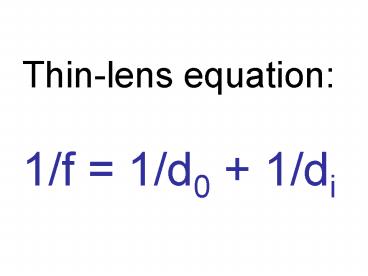Thin-lens equation: 1/f = 1/d0 1/di - PowerPoint PPT Presentation
1 / 14
Title:
Thin-lens equation: 1/f = 1/d0 1/di
Description:
Spherical aberration can be reduced by using a diaphragm to block rays far from the center of the lens. A parabolic surface lens also reduces spherical aberration, ... – PowerPoint PPT presentation
Number of Views:296
Avg rating:3.0/5.0
Title: Thin-lens equation: 1/f = 1/d0 1/di
1
Thin-lens equation1/f 1/d0 1/di
2
Magnification equationhi/ho di/do
3
do and di are positive for real objects and real
imagesdo and di are negative for virtual
objects and virtual imagesf is positive for
converging lensesf is negative for diverging
lensesmagnification is positive for an image
that is upright, negative for an image that is
inverted
4
Ex. 8 - A 1.70-m tall person is standing 2.50 m
in front of a camera. The camera uses a
converging lens whose focal length is 0.0500 m.
(a) Find the image distance and determine
whether the image is real or virtual. (b) Find
the magnification and height of the image on the
film.
5
Ex. 9 - An object is placed 7.10 cm to the left
of a diverging lens whose focal length is f
-5.08 cm. (a) Find the image distance and
determine whether the image is real or virtual.
(b) Obtain the magnification.
6
When a combination of lenses and/or mirrors is
used, the image produced by one lens serves as
the object for the next lens.
7
Ex. 10 - The objective and eyepiece of a compound
microscope are both converging lenses and have
focal lengths of fo 15.0 mm and fe 25.5 mm.
A distance of 61.0 mm separates the lenses. The
microscope is being used to examine an object
placed do1 24.1 mm in front of the objective.
Find the final image distance.
8
The angular size in radians of an object is
approximately equal to the height of the object
ho divided by the distance to the object do,
q(in radians) ho/do.
9
Spherical aberration is blurring caused by
spherical lenses. Rays far from the principle
axis are refracted more than paraxial rays, so
they focus closer to the lens than paraxial rays.
10
Rays are difficult to focus since there is not a
unique focal point. The most satisfactory image
is formed at the circle of least confusion.
11
Spherical aberration can be reduced by using a
diaphragm to block rays far from the center of
the lens. A parabolic surface lens also reduces
spherical aberration, but these are expensive.
12
Chromatic aberration is caused by the fact that
the index of refraction varies with wavelength.
Shorter waves (violet) are refracted more than
longer wavelengths (red). In essence, the lens
acts as a prism and disperses the light.
13
This produces a color fringe around an image.
Chromatic aberration can be reduced by using a
combination of converging and diverging lenses.
This combination is called an achromatic lens
(without color).
14
(No Transcript)































